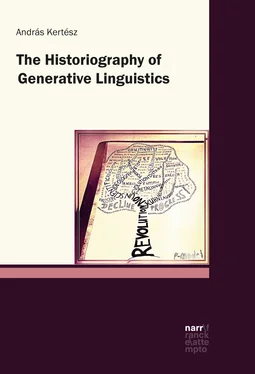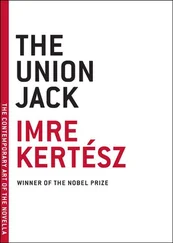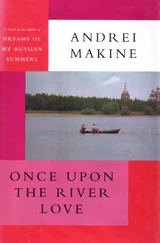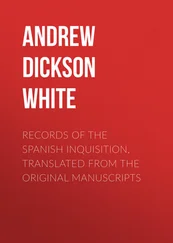1 ...7 8 9 11 12 13 ...23 In summary:
| (SP6) |
The basic term of the historiographyhistoriography of generative linguistics with respect to Syntactic Structures Syntactic Structures is ›the formalformal sciencesscienceformal‹, its central hypothesis is (T6) and its framework is the comparison of the mathematicalmathematical and logicallogic literature with the literature of American linguistics prior to literature before 1957. |
2.1.2.3 One of the neo-Bloomfieldianneo-BloomfieldianBloomfieldian trends
HymesHymes, Dell and FoughtFought, John (1981) [1975] is one of the historiographicalhistoriography approaches questioning the kind of historical account which attributes revolutionaryrevolutionary relevance to Syntactic Structures Syntactic Structures , and instead interprets the latter as an organic part of neo-Bloomfieldian structuralismstructuralism. Hymes and Fought (1981 [1975]: 155–156) argue for the following thesis, which TomalinTomalin, Marcus (2008: 11) calls »provocative«:
| (T7) |
(a) |
Neo-Bloomfieldian structuralismstructuralism was not a coherent school, but consisted of a variety of alternative trends and individual initiatives. |
|
(b) |
Within neo-Bloomfieldianneo-BloomfieldianBloomfieldian structuralism,structuralism Syntactic Structures Syntactic Structures contributed to the victory of Zellig S. HarrisHarris, Zellig S.’s approach over that of TragerTrager, George L. and Smith’Smith, Henry Lees (1957). |
The authors emphasize that the ›climate of opinionclimate of opinion‹ did not change immediately after 1957 under the influence of the appearance of Syntactic Structures Syntactic Structures .1 ChomskyChomsky, Noam’s work was evaluated as one of the standpoints within neo-Bloomfieldianism. It was not considered as a challenge that might lead to the redefinition of the discipline (HymesHymes, Dell & FoughtFought, John 1981 [1975]: 154).
In their book on American structuralismstructuralism – in which ChomskyChomsky, Noam’s activity is only one episode – the authors devote much space to the methodologymethodology of linguistic historiographyhistoriography. They suggest the simultaneous consideration of a series of factors. Among others, referring to PercivalPercival, W. Keith (1976a) they reject the application of KuhnKuhn, Thomas S.’s approach to linguistics (HymesHymes, Dell & FoughtFought, John 1981: 24–25, 239–241, 245–246) and criticize KoernerKoerner, E.F. Konrad (1978). They also reject an approach which builds linguistic historiography on one basic term such as ›paradigmparadigm‹ and claim that »a single term will not suffice« (Hymes & Fought 1981 [1975]: 25). Much more complex and differentiated terms are needed in order to capture »the rich range of materials actually forming the datadata to be explained« which every »serious historiography« is expected to use (Hymes & Fought 1981: 25). These materials also include personal and institutional dynamics as well as unpublished documents. The authors discuss the range of data which they believe to be potentially relevant for historiographical research. Naturally, these principles apply to the historiography of linguistics in general and to that of generative linguistics in particular.
| (SP7) |
The historiographyhistoriography of generative linguistics does not rely on a single basic term; rather, with respect to Syntactic Structures Syntactic Structures , it requires a network of terms which is able to grasp the differentiated and complex nature of the historyhistory of linguistics; its central hypothesis is (T7); and its framework is the sophisticated combination of the terms, sources and analytical aspects of historiographical research. |
2.1.2.4 The improvement of distributionalismdistributional
On the first pages of his book about American structuralismstructuralism, Peter MatthewsMatthews, Peter H., with heavy irony, criticizes the unreflected, mechanical applications of KuhnianKuhnian terms in oversimplifying didactic chronicles of the historyhistory of linguistics. He believes that »[…] the Worst Thing that has happened to the historiographyhistoriography of twentieth century linguistics« is the publication of Thomas S. KuhnKuhn, Thomas S.’s The Structure of Scientific Revolutions because »it led so many of ChomskyChomsky, Noam’s supporters to make events fit Kuhn’s model« (Matthews 1993: 28). As a result of this, the application of Kuhn’s historiographical model to generative linguistics »partly obscured its real origins« (ibid).
MatthewsMatthews, Peter H. does not divide neo-Bloomfieldianneo-Bloomfieldianism into trends as HymesHymes, Dell and FoughtFought, John do. He scrutinizes Bloomfield’s texts and those of the neo-Bloomfieldians, and compares them to Syntactic Structures Syntactic Structures and other texts that ChomskyChomsky, Noam published before or right after it. He does not go into details about the Theory of Government and BindingGovernment and Binding, Theory of, and the Minimalist ProgramMinimalist Program was established only after the publication of Matthews’ book. His main thesis is the following:
| (T8) |
Syntactic Structures Syntactic Structures is the direct continuation and the improvement of the distributionalismdistributional of BloomfieldianBloomfieldian and neo-Bloomfieldianneo-Bloomfieldian linguistics. |
MatthewsMatthews, Peter H. does not make his methodologymethodology explicit. Nevertheless, it is clear for the readers of his book that, in accordance with this thesis, he focuses on the role of distribution both in neo-Bloomfieldianneo-BloomfieldianBloomfieldian approaches and in Syntactic Structures Syntactic Structures . In his opinion, ChomskyChomsky, Noam
[…] did not abandon the essential goal of distributionalismdistributional, or […] the empiricism that pervaded it. […] In abandoning the requirement that linguistic theorytheory should provide what he called a ›discovery procedurediscovery procedure‹ he liberated distributionalism from a constraint that was inessential. But what replaced it was the requirement that alternative sets of distributional rules should be evaluated by a measure of simplicitysimplicity. This was an attempt to rescue the programme, not to destroy it (MatthewsMatthews, Peter H. 1993: 141; emphasis added).1
MatthewsMatthews, Peter H.’ (1993), (2001) method centers on philology and the historyhistory of ideas. Based on a careful, many-sided and differentiated philological analysis and comparison of texts written in different periods by different authors, it outlines the history of the ideas shaping American structuralismstructuralism. Thus:
| (SP8) |
The basic term of the historiographyhistoriography of generative linguistics with respect to Syntactic Structures Syntactic Structures is ›distribution‹, its central hypothesis is (T8) and its framework is the careful philological comparison of a wide range of written sources. |
2.1.2.5 ChomskyChomsky, Noam as a metalinguistmetalinguist
SeurenSeuren, Pieter A.M. (1998) overviews the historyhistory of Western linguistics from the point of view of the philosophy of sciencephilosophy of science. According to Seuren (1998: 250, 252), the main achievement of ChomskyChomsky, Noam’s work is the following:
| (T9) |
(a) |
Syntactic Structures Syntactic Structures is original insofar as it systematized and critically evaluated the theses, terms and methods of neo-Bloomfieldian structuralismstructuralism. |
|
(b) |
In comparison to neo-Bloomfieldianism, the novelty of Syntactic Structures Syntactic Structures is of a metatheoretical,metatheoretical rather than of a linguistic nature. |
SeurenSeuren, Pieter A.M. does not consider ChomskyChomsky, Noam’s achievements revolutionaryrevolutionary. He argues that generative linguistics is basically rooted in the work of Zellig S. HarrisHarris, Zellig S., while Chomsky synthesized and improved his findings. They were thinking along the same lines and continuitycontinuity can be observed between their works. Seuren believes that besides Chomsky’s synthesizing work, his greatest achievement is that by raising and answering pivotal metatheoreticalmetatheoretical questions, he applied the terms and principles of the philosophy of sciencephilosophy of science to linguistics. Thus his greatest achievement is to have placed linguistics in the context of the philosophy of science. In Seuren’s view, »most of Chomsky’s work in theoretical linguistics deals with metatheoretical questions, which makes Chomsky a metalinguistmetalinguist rather than a linguist« (Seuren 1998: 252; emphasis added). He called attention to issues which had fallen outside the scope of neo-Bloomfieldianneo-Bloomfieldianism: the nature of linguistic datadata, realism vs. nominalism, the criteria of adequacy, formalization, explanation, causality etc. (Seuren 1998: 252ff.).
Читать дальше












